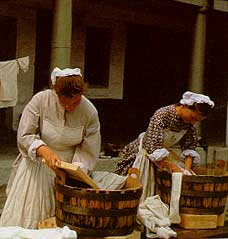|
 Accounts by laundresses of their experiences do not exist, probably because few if any were literate. In a day when many women had no schooling at all and signed their names with marks, the laundresses had little opportunity to advance intellectually or culturally. Their lives revolved around hot tubs of soapy water and mounds of dirty clothes. Accounts by laundresses of their experiences do not exist, probably because few if any were literate. In a day when many women had no schooling at all and signed their names with marks, the laundresses had little opportunity to advance intellectually or culturally. Their lives revolved around hot tubs of soapy water and mounds of dirty clothes.
Of all the women who accompanied troops to the frontiers, the laundresses, also referred to as washerwomen, were the only women recognized by army regulations. While the institution of laundresses in the army had been inherited from the British in the days of the American Revolution, it wasn't until 1802, that an act was passed which regulated their numbers by the ratio of one per every 17 men, not to exceed 4 per company. At Fort Scott, the ratio was 1 laundress to 15 soldiers. Fort Scott was built as a three company post, although the number of companies varied throughout the years.
Regulations also provided the laundresses with one ration of food per day. This ration may have only consisted of a meager offering of meat, bread, and whiskey. The washerwomen also received bedding straw and the services of the post surgeon. The Post Council of Administration, made up of three officers, determined the fees that could be charged for laundry services. At two forts in the 1830s and 40s, the rate was fifty cents per month for each soldier, two dollars for single officers, and four dollars for married officers, children and servants, extra. Laundresses and their children were allowed to ride in wagons on long marches. Laundresses were also protected from nonpayment of the soldiers' bills. Regulations specified that when the company mustered for pay, the laundress' bill was deducted from the soldiers pay before payment of his debt to the sutler.
Time has depicted the laundress as a shady lady of the night, however, records indicate that most of them were married women, trying very hard to raise a family under less than ideal conditions. Laundresses were most often married to a noncommissioned officer.
Now, women didn't just magically appear out here on the plains to sign up as laundresses. Most of them joined the army back East somewhere and came out West with the troops. In later years, as the country became populated, it was easier to find laundresses in the West. However, most of the early laundresses came West with their families and husbands, who were usually non commisioned officers.
Besides wanting to be with her husband, why would a woman want to be a laundress if conditions were so atrocious? The answer is easy --- Money. A laundress was hired to wash for an average of fifteen soldiers. She received fifty cents per month from each man, and luckily this was taken from his wages before he got them, or the laundress probably would have never seen her money. Her rates were established by a Post Council of Administration. This fifty cents per month for each soldier and four dollars from each officer, made the laundress a well-paid individual according to the wages on the post. Her soldier husband, depending on his rank, would earn only ten dollars a month if he was a corporal and thirteen dollars if he was a sergeant. In addition, she could charge a little extra for assisting officers' wives as midwives and nurses, baking extra goodies for soldiers and mending. No matter how you look at it, the laundress was better paid than an enlisted men and depending on their husband's rank, might even make more than he did. Between the two, they had a very respectable income, especially when all the side benefits were included. You might say they were the first of the two-income families out on the plains.
Laundresses were on the low end of the social class and for the most part were not refined ladies. Some were rough, outspoken, course, uneducated and argumentative. They occasionally caused trouble on the post, smoked, drank, and even got into fights. But most were good, honest, industrious, kindhearted, married women who were a good influence on the soldiers.
Since most laundresses were illiterate, they did not leave journals, letters, diaries, etc. so documentation on their daily lives is sketchy. Most of the documentation that does exist comes from military records and other people who wrote about laundresses in their diaries, journals, etc.
Information from this section was taken from the Historic Furnishings Report :The Dragoon Barracks by Sally Johnson Ketchum and from an article entitled Sabers and Soapsuds: Dragoon Women on the Frontier written by Dana H. Prater.
|






 Accounts by laundresses of their experiences do not exist, probably because few if any were literate. In a day when many women had no schooling at all and signed their names with marks, the laundresses had little opportunity to advance intellectually or culturally. Their lives revolved around hot tubs of soapy water and mounds of dirty clothes.
Accounts by laundresses of their experiences do not exist, probably because few if any were literate. In a day when many women had no schooling at all and signed their names with marks, the laundresses had little opportunity to advance intellectually or culturally. Their lives revolved around hot tubs of soapy water and mounds of dirty clothes.